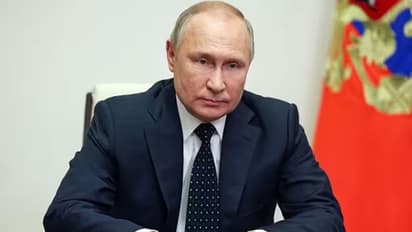Putin confirms Russia fired experimental ballistic missile Oreshnik on Ukraine, warns the West (WATCH)

Synopsis
The strike, which occurred Thursday, marked an escalation in the ongoing conflict and came in response to Ukrainian attacks on Russian territory earlier this week, reportedly using US and UK supplied missiles.
In a dramatic televised address, Russian President Vladimir Putin confirmed that Russia had fired an experimental medium-range hypersonic ballistic missile, Oreshnik, targeting the Yuzhmash military facility in the Ukrainian city of Dnipro.
The strike, which occurred Thursday, marked an escalation in the ongoing conflict and came in response to Ukrainian attacks on Russian territory earlier this week, reportedly using US and UK supplied missiles.
“The deployment of the Oreshnik system was a response to US plans to produce and deploy intermediate- and short-range missiles … In the event of an escalation, Russia will respond decisively and symmetrically,” Putin said.
The Oreshnik missile, touted as a state-of-the-art weapon, was reportedly equipped with a MIRVed (multiple independently targetable reentry vehicle) payload, typically associated with nuclear-capable systems. However, there was no indication that the missile launched in Dnipro carried a nuclear warhead.
Initial Ukrainian reports had speculated that Russia had used an intercontinental ballistic missile (ICBM), a weapon designed for long-range nuclear strikes and never before deployed in combat. However, US officials later clarified that the missile appeared to be an intermediate-range ballistic missile (IRBM) with a range of 3,000-5,500 km.
Fabian Hoffmann, a missile technology and nuclear strategy expert from Oslo University, noted the significance of the MIRVed payload.
“Whether it was an ICBM or an IRBM, the range isn’t the important factor. “The fact that it carried a MIRVed [multiple independently targetable reentry vehicle] payload is much more significant for signalling purposes and is the reason Russia opted for it. This payload is exclusively associated with nuclear-capable missiles," he told Associated Press.
Putin warns the West
During the address, Putin issued stark warnings to Western nations, particularly Britain and the United States. He stated, “Russia reserves the right to use weapons against targets in countries that permit their weapons to be used against Russian targets.”
Putin claimed Western missile defense systems would be ineffective against advanced Russian weapons like Oreshnik and pledged that Russia would provide advance warnings of strikes to minimize civilian casualties.
The strike and Putin’s comments have intensified fears of broader escalation in the conflict. The Yuzhmash facility in Dnipro, targeted in the strike, is a key hub for Ukraine’s military-industrial complex. Ukrainian officials condemned the attack as an unjustified provocation.
Key highlights of Putin's televised address
- Russian President Vladimir Putin said that on November 19 and November 21, Ukraine launched attacks using six ATACMS missiles and Storm Shadow systems, targeting sites in the Kursk and Bryansk regions.
- Combat tests of the Oreshnik missile system are being conducted in response to aggressive actions by NATO countries against Russia. The missiles reached a speed of Mach 10, equivalent to 2.5–3 kilometers per second. Modern air defense and missile defense systems, including those in Europe, cannot intercept it.
- The conflict in Ukraine has taken on global dimensions following long-range Western missile strikes on Russia.
- Russia hit a complex in Dnepropetrovsk that produces, among other things, missile technology.
- Russia considers itself entitled to use weapons against military facilities of countries that allow their weapons to be used against Russia.
- Russia will offer civilians in Ukraine and citizens of other friendly states the chance to leave potential strike zones in advance, Putin said.
Check the Breaking News Today and Latest News from across India and around the world. Stay updated with the latest World News and global developments from politics to economy and current affairs. Get in-depth coverage of China News, Europe News, Pakistan News, and South Asia News, along with top headlines from the UK and US. Follow expert analysis, international trends, and breaking updates from around the globe. Download the Asianet News Official App from the Android Play Store and iPhone App Store for accurate and timely news updates anytime, anywhere.